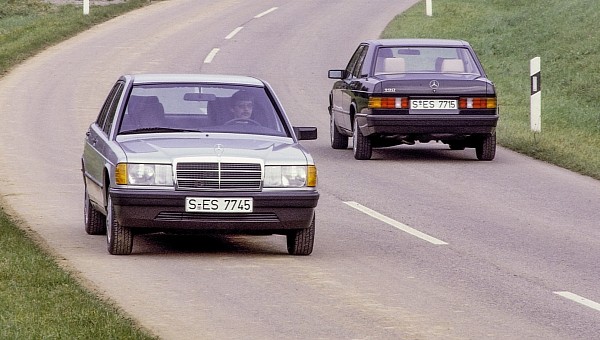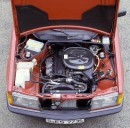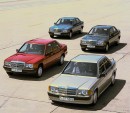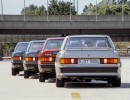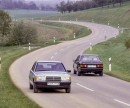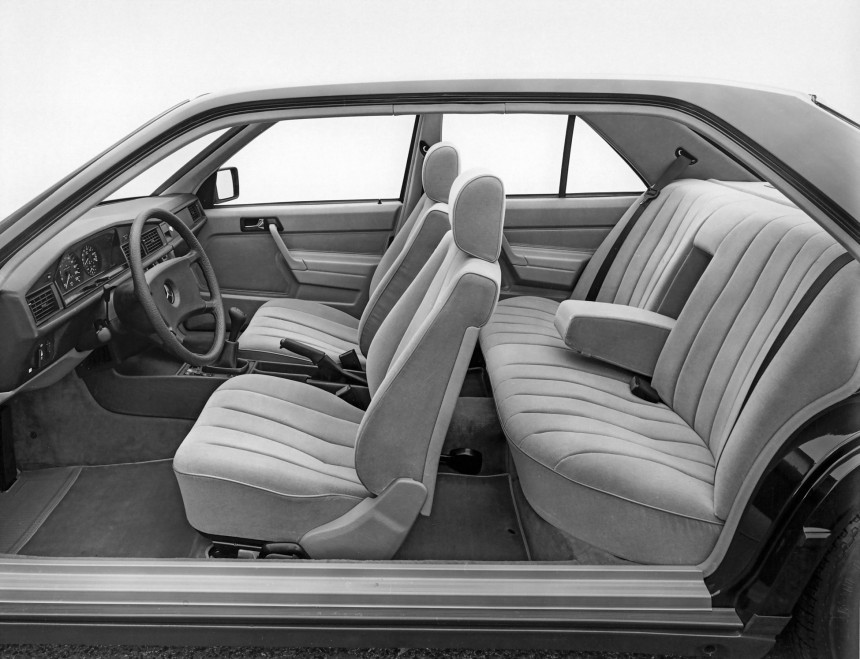In late October 1982, Mercedes-Benz introduced a surprising new model at the Paris Motor Show. It wasn't flashy or luxurious, unlike the rest of the carmaker's range. Instead, it was just smaller and with an attractive price: the 190.
In 1970, the U.S. adopted the "Clean Air Act," which imposed a specific average fuel consumption per manufacturer. That was the beginning of the end of the Muscle Car era in the U.S. and, for luxury carmakers, a wake-up call that told them to lower their gas-guzzling engines. In 1975, the U.S. Congress introduced an amendment that enforced an average fuel consumption of just 8.3 l/100 km (28.3 mpg-U.S.) starting in 1985. Fortunately, Mercedes-Benz has already started to work on the 190 (W201), also known as the "Baby-Benz."
In 1975, Bruno Sacco was head of styling at Mercedes-Benz, and he penned the car with a vision. He considered that all vehicles from the three-pointed-star brand should share a common brand identity. The idea wasn't new, and it belonged to Peter Pfeiffer, another famous car stylist who worked on the 190, who said, "Even a Baby-Benz has to look like a Mercedes-Benz, but not like a scaled-down S-Class." That idea bloomed in Sacco's head. Thus, he made the headlights rectangular and a grille resembling former MB vehicles.
That design signature was later on applied to other cars produced by the German automaker. But the road from the first sketch to the vehicle's unveiling was long and expensive. The project took about 1.4-billion Deutsche Marks from the company's pockets. That would translate into more than 630 million USD. It was the most expensive single project for the German automaker.
One of the main objectives of the R&D department was to create a fuel-efficient vehicle. Thus, that would allow the carmaker to develop the luxurious S-Class and other cars that were not so savvy on the gas pump. In addition, a diesel engine was also considered. But first, the car had to provide a low drag coefficient, and Sacco and his team managed to create a bodywork with a Cd of just 0.34. Maybe that value doesn't tell you too much. Let's say that, at that time, it was the most aerodynamic sedan in the German automaker's range.
With such a timeless design that made most other vehicles on the market look outdated, the engineering team had to create a better platform. Thus, it created a new rear axle system with a five tie-rods multi-link rear suspension. That was an essential upgrade over other cars on the market since it offered a comfortable ride and a respectable cornering speed. And then came the engine lineup.
In 1982, the new 190 started its lineup with a humble 89 hp (90 ps) engine fed by a carburetor. A fuel-injected version bumped that value to 118 hp for the 190 E, where the "E" letter stood for "Einspritzung," which means "Injection." In the following year, the 190 received a 72 hp diesel powerplant, the famous OM601, one of the most reliable engines ever made by Mercedes-Benz.
While the Europeans got the 2.0-liter version of this unit, due to higher taxes for engines over that displacement, customers from the U.S. and Canada received a 2.2-liter mill, which helped lower the average fuel consumption for the German automaker. That's how the S-Class could receive V8s underneath its hood.
Yet, customers were somehow disappointed due to the car's performance. Neither engine offered could lower the 0 to 60 mph (0-97 kph) under the 10-second barrier if fitted with the four-speed manual or, even worse, with the four-speed automatic. Only the five-speed manual paired with the 121 hp (122 ps) could get that. But that was changed in 1983 when the 2.3-liter inline-four fitted with fuel injection found its place in the engine bay and lowered those numbers.
Meanwhile, in Europe, the German automaker faced stiff competition from the BMW E30 in the German Touring Car Championship (DTM). That motivated Mercedes-Benz to create a new powerplant: the 2.3-liter 16-valves version that provided 182 hp (185 ps). With three slightly modified vehicles, Mercedes-Benz established three world records in August 1983 at the Nardo Circuit in Italy. The average combined speed of the test cars was 247.94 kph (154.06 mph) over a distance of 50,000 km (31,069 miles). Finally, the Baby-Benz was not just a comfortable, fuel-efficient vehicle but also a fast one. That gave the carmaker confidence to provide a batch of cars for a unique race run in 1984 for the Nurburgring Race of Champions, where an unknown driver took the cup. His name was Ayrton Senna.
Even though it wasn't that successful in the German Touring Car Championship (DTM), the 190 gained the reputation for being a sporty mid-size sedan (according to those times' standards). Later developments of the 2.3-16v came in the form of the Evo I and II, which bumped the power up to 235 hp. In addition, the latter version featured a unique aerodynamic package that helped the car lower the Cd to 0.19, which was truly remarkable for a 1990 vehicle.
But Mercedes-Benz knew it had to give up on the original Baby Benz. In April 1993, the final 190 left the assembly lines after more than 1.8 million units had been produced. It's still one of the most successful cars produced by the German automaker. Its legacy was carried over by the first generation of the C-Class, a range still made today.
Four decades after the introduction of the 190 range, the Baby Benz is still cherished and respected worldwide. Its reliability and advanced features for its time made it a true classic. In addition, its fuel efficiency allowed Mercedes-Benz to produce vehicles with larger engines and still not get fined for exceeding the average fuel consumption per manufacturer.
In 1975, Bruno Sacco was head of styling at Mercedes-Benz, and he penned the car with a vision. He considered that all vehicles from the three-pointed-star brand should share a common brand identity. The idea wasn't new, and it belonged to Peter Pfeiffer, another famous car stylist who worked on the 190, who said, "Even a Baby-Benz has to look like a Mercedes-Benz, but not like a scaled-down S-Class." That idea bloomed in Sacco's head. Thus, he made the headlights rectangular and a grille resembling former MB vehicles.
That design signature was later on applied to other cars produced by the German automaker. But the road from the first sketch to the vehicle's unveiling was long and expensive. The project took about 1.4-billion Deutsche Marks from the company's pockets. That would translate into more than 630 million USD. It was the most expensive single project for the German automaker.
One of the main objectives of the R&D department was to create a fuel-efficient vehicle. Thus, that would allow the carmaker to develop the luxurious S-Class and other cars that were not so savvy on the gas pump. In addition, a diesel engine was also considered. But first, the car had to provide a low drag coefficient, and Sacco and his team managed to create a bodywork with a Cd of just 0.34. Maybe that value doesn't tell you too much. Let's say that, at that time, it was the most aerodynamic sedan in the German automaker's range.
In 1982, the new 190 started its lineup with a humble 89 hp (90 ps) engine fed by a carburetor. A fuel-injected version bumped that value to 118 hp for the 190 E, where the "E" letter stood for "Einspritzung," which means "Injection." In the following year, the 190 received a 72 hp diesel powerplant, the famous OM601, one of the most reliable engines ever made by Mercedes-Benz.
While the Europeans got the 2.0-liter version of this unit, due to higher taxes for engines over that displacement, customers from the U.S. and Canada received a 2.2-liter mill, which helped lower the average fuel consumption for the German automaker. That's how the S-Class could receive V8s underneath its hood.
Yet, customers were somehow disappointed due to the car's performance. Neither engine offered could lower the 0 to 60 mph (0-97 kph) under the 10-second barrier if fitted with the four-speed manual or, even worse, with the four-speed automatic. Only the five-speed manual paired with the 121 hp (122 ps) could get that. But that was changed in 1983 when the 2.3-liter inline-four fitted with fuel injection found its place in the engine bay and lowered those numbers.
Even though it wasn't that successful in the German Touring Car Championship (DTM), the 190 gained the reputation for being a sporty mid-size sedan (according to those times' standards). Later developments of the 2.3-16v came in the form of the Evo I and II, which bumped the power up to 235 hp. In addition, the latter version featured a unique aerodynamic package that helped the car lower the Cd to 0.19, which was truly remarkable for a 1990 vehicle.
But Mercedes-Benz knew it had to give up on the original Baby Benz. In April 1993, the final 190 left the assembly lines after more than 1.8 million units had been produced. It's still one of the most successful cars produced by the German automaker. Its legacy was carried over by the first generation of the C-Class, a range still made today.
